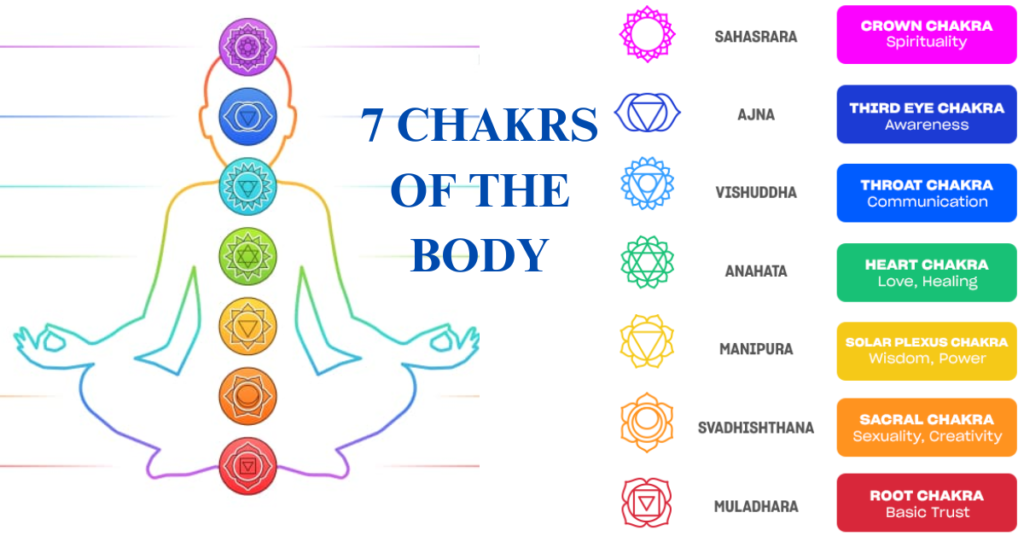Table of Contents
7 Chakras in body : Understanding the Energy Centers of the Human Body
7 Chakras in body: The concept of chakras is a cornerstone of ancient Indian traditions, particularly within Hinduism and Buddhism. The word “chakra” comes from Sanskrit, meaning “wheel” or “disk,” and is used to describe spinning vortices of energy located along the spine. Each Chakras of the Body is associated with specific physical, emotional, and spiritual functions. There are seven main chakras, starting at the base of the spine and extending to the crown of the head, each linked with particular colors, elements, and attributes. Balancing these chakras is considered essential for optimal health and well-being. This article explores the 7 Chakras of the body, their significance, and their impact on our lives.


7 Chakras in body given below
Significance of 7 chakras of the body:
1. Root Chakra (Muladhara)
Location: Base of the spine
Color: Red
Element: Earth
The Root Chakra, or Muladhara, serves as the foundation of our energy system. It provides grounding and stability, connecting us to the Earth and influencing our basic survival needs, such as food, shelter, and security.
A balanced Root Chakra fosters feelings of safety and stability, enabling us to face life’s challenges with confidence. When this chakra is balanced, we feel secure and grounded, both physically and emotionally.
Imbalance Symptoms: An imbalance in the Root Chakra can lead to anxiety, fear, insecurity, and financial instability. Physical symptoms may include lower back pain, leg and foot issues, and problems with the colon and bladder.
Balancing Techniques: Grounding exercises, spending time in nature, and walking barefoot on the earth can help balance this chakra. Yoga poses like the Tree Pose and Mountain Pose are also beneficial.
2. Sacral Chakra (Svadhisthana)
Location: Lower abdomen, just below the navel
Color: Orange
Element: Water
Significance: The Sacral Chakra, or Svadhisthana, is the center of creativity, pleasure, and emotional expression. It governs relationships, sexual energy, and the ability to embrace change and joy. This chakra influences our sense of well-being and enjoyment of life.
A balanced Sacral Chakra allows us to embrace our emotions, express ourselves creatively, and maintain healthy relationships. It promotes a fluid and joyful experience of life.
Imbalance Symptoms: Emotional instability, fear of change, sexual dysfunction, and relationship difficulties can indicate an imbalanced Sacral Chakra. Physical symptoms might include reproductive organ issues, urinary problems, and lower abdomen pain.
Balancing Techniques: Creative activities, nurturing relationships, and yoga poses like the Bound Angle Pose and Cobra Pose can help balance this chakra. Spending time near water or engaging in water-related activities can also be beneficial.
3. Solar Plexus Chakra (Manipura)
Location: Upper abdomen, around the stomach area
Color: Yellow
Element: Fire
Significance: The Solar Plexus Chakra, or Manipura, is the center of personal power, self-esteem, and confidence. It influences our ability to control our lives and make decisions. This chakra is associated with our sense of identity and personal power.
A balanced Solar Plexus Chakra enables us to pursue our goals confidently, assert ourselves, and maintain healthy self-esteem. It is the driving force behind our willpower and personal authority.
Imbalance Symptoms: Low self-esteem, lack of self-control, and feelings of powerlessness can signal an imbalance in the Solar Plexus Chakra. Physical symptoms might include digestive issues, ulcers, and liver or pancreas problems.
Balancing Techniques: Setting and achieving personal goals, core-strengthening exercises, and yoga poses like the Boat Pose and Warrior Pose can help balance this chakra. Consuming yellow-colored foods like bananas and corn can also support this chakra.
4. Heart Chakra (Anahata)
Location: Center of the chest, near the heart
Color: Green
Element: Air
Significance: The Heart Chakra, or Anahata, is the bridge between the lower and upper chakras, symbolizing love, compassion, and empathy. It governs our ability to give and receive love unconditionally, fostering a deep sense of connection with others and with ourselves.
A balanced Heart Chakra allows us to form healthy, loving relationships, practice self-love, and experience inner peace and harmony. It is essential for emotional balance and well-being.
Imbalance Symptoms: Jealousy, bitterness, loneliness, and relationship difficulties can indicate an imbalanced Heart Chakra. Physical issues might involve heart problems, respiratory issues, and upper back pain.
Balancing Techniques: Practices that foster love and compassion, such as volunteering, practicing gratitude, and spending time with loved ones, can help balance this chakra. Yoga poses like the Camel Pose and Bridge Pose are also beneficial.
5. Throat Chakra (Vishuddha)
Location: Throat
Color: Blue
Element: Ether (Space)
Significance: The Throat Chakra, or Vishuddha, is associated with communication, self-expression, and truth. It enables us to speak our truth, express our thoughts and feelings clearly, and listen effectively. This chakra influences our ability to communicate authentically and with integrity.
A balanced Throat Chakra allows us to express ourselves confidently and truthfully, fostering clear and honest communication.
Imbalance Symptoms: Difficulty expressing oneself, fear of speaking, and communication problems can signal an imbalanced Throat Chakra. Physical symptoms might include sore throats, thyroid issues, and neck pain.
Balancing Techniques: Singing, chanting, and engaging in open and honest communication can help balance this chakra. Yoga poses like the Fish Pose and Shoulder Stand are also supportive. Drinking plenty of water and wearing blue-colored clothing can enhance this chakra’s energy.
6. Third Eye Chakra (Ajna)
Location: Forehead, between the eyes (also known as the brow chakra)
Color: Indigo
Element: Light
Significance: The Third Eye Chakra, or Ajna, is the center of intuition, insight, and spiritual awareness. It governs our ability to perceive and understand the world through intuition and psychic abilities. This chakra is associated with our ability to visualize and manifest our goals.
A balanced Third Eye Chakra allows us to access inner wisdom, trust our intuition, and see beyond the physical realm. It enhances our spiritual insight and clarity of thought.
Imbalance Symptoms: Lack of intuition, difficulty concentrating, and disconnection from reality can signal an imbalance in the Third Eye Chakra. Physical symptoms might include headaches, vision problems, and sinus issues.
Balancing Techniques for Chakras of the Body: Meditation, visualization, and introspection can help balance this chakra. Yoga poses like the Child’s Pose and Eagle Pose are also beneficial. Spending time in natural light and practicing mindfulness can enhance this chakra’s energy.
7. Crown Chakra (Sahasrara)
Location: Top of the head
Color: Violet or White
Element: Thought
Significance: The Crown Chakra, or Sahasrara, represents our connection to the divine, spiritual enlightenment, and universal consciousness. It is the gateway to higher states of consciousness and spiritual awakening, influencing our sense of purpose and our understanding of the universe.
A balanced Crown Chakra allows us to experience spiritual connection, inner peace, and a sense of oneness with the universe. It enhances our spiritual growth and enlightenment.
Imbalance Symptoms: Spiritual disconnection, lack of purpose, and feelings of isolation can indicate an imbalance in the Crown Chakra. Physical symptoms might include headaches, cognitive issues, and problems related to the nervous system.
Balancing Techniques for Chakras of the Body: Meditation, prayer, and engaging in spiritual activities can help balance this chakra. Yoga poses like the Headstand and Lotus Pose are also supportive. Spending time in silence and connecting with nature can enhance this chakra’s energy.
The 7 chakras of the body are crucial energy centers in the body, each governing specific physical, emotional, and spiritual aspects. The Root Chakra provides stability and grounding, essential for basic survival needs. The Sacral Chakra influences creativity, pleasure, and emotional expression. The Solar Plexus Chakra is the seat of personal power and confidence. The Heart Chakra bridges physical and spiritual realms through love and compassion. The Throat Chakra facilitates clear communication and self-expression. The Third Eye Chakra enhances intuition and insight. Finally, the Crown Chakra connects us to spiritual enlightenment and universal consciousness, fostering holistic well-being. Balancing these Chakras of the Body promotes overall health and harmony.
Conclusion
Understanding the 7 chakras of the body offers valuable insights into the interconnectedness of our physical, emotional, and spiritual health. Each chakra plays a vital role in our overall well-being, influencing various aspects of our lives. By paying attention to these energy centers and striving for balance through practices like meditation, yoga, and mindful living, we can achieve greater harmony and fulfillment. Embracing the wisdom of the chakras allows us to cultivate a deeper connection with ourselves and the world around us, promoting a holistic sense of health and well-being.


